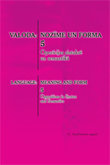Divkāršais noliegums sengrieķu valodā
Double negation in Ancient Greek
Author(s): Gita BērziņaSubject(s): Language studies, Language and Literature Studies, Foreign languages learning, Theoretical Linguistics, Syntax, Historical Linguistics
Published by: Latvijas Universitātes Akadēmiskais apgāds
Keywords: divkāršs noliegums; sengrieķu valoda; izteikuma strukturējums; semantika; ekspresija;
Summary/Abstract: The paper deals with the negation in Ancient Greek. Special attention is paid to the principles and practise of use of double negation, and the possibilities to translate it in Latvian.The analysis of the Ancient Greek language material discloses complex system and shows that varied use of different linguistic elements and means (from simple negative particles to specialized structure of utterance) serves for rendering nuanced semantics of negation. Negation may be partial or absolute. And a variety of elements and aspects have their significance in expression of negative meaning, namely, particular position of negative unit in the utterance, accumulation and mutual combination of several negative units, lexical meaning and grammatical form of the nearby elements, general structure and modality of the utterance, as well as wider context. Possibilities to tanslate negation expressed in Ancient Greek into Latvian are varied. In some cases, it is possible to translate the negation precisely, however in other cases different linguistic means must be used to render the complex semantics of the Ancient Greek utterance, taking into account the particular context, time and modality of the utterance.
Journal: Valoda: nozīme un forma
- Issue Year: 2014
- Issue No: 5
- Page Range: 20-32
- Page Count: 13
- Language: Latvian

